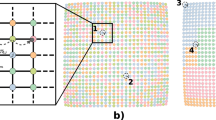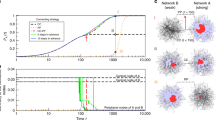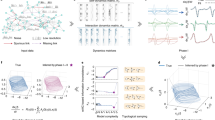Abstract
In recent years the increasing availability of computer power and informatics tools has enabled the gathering of reliable data quantifying the complexity of socio-technical systems. Data-driven computational models have emerged as appropriate tools to tackle the study of dynamical phenomena as diverse as epidemic outbreaks, information spreading and Internet packet routing. These models aim at providing a rationale for understanding the emerging tipping points and nonlinear properties that often underpin the most interesting characteristics of socio-technical systems. Here, using diffusion and contagion phenomena as prototypical examples, we review some of the recent progress in modelling dynamical processes that integrates the complex features and heterogeneities of real-world systems.
This is a preview of subscription content, access via your institution
Access options
Subscribe to this journal
Receive 12 print issues and online access
$209.00 per year
only $17.42 per issue
Buy this article
- Purchase on Springer Link
- Instant access to full article PDF
Prices may be subject to local taxes which are calculated during checkout




Similar content being viewed by others
References
Keeling, M. J. & Rohani, P. Modeling Infectious Diseases in Humans and Animals (Princeton Univ. Press, 2008).
Goffman, W. & Newill, V. A. Generalization of epidemic theory: An application to the transmission of ideas. Nature 204, 225–228 (1964).
Rapoport, A. Spread of information through a population with socio-structural bias: I. Assumption of transitivity. Bull. Math. Biol. 15, 523–533 (1953).
Tabah, A. N. Literature dynamics: Studies on growth, diffusion, and epidemics. Annu. Rev. Inform. Sci. Technol. 34, 249–286 (1999).
Lloyd, A. L. & May, R. M. How viruses spread among computers and people. Science 292, 1316–1317 (2001).
Grassberger, P. On the critical behavior of the general epidemic process and dynamical percolation. Math. Biosci. 63, 157–172 (1983).
Harris, T. E. Contact interactions on a lattice. Ann. Prob. 2, 969–988 (1974).
Marro, J. & Dickman, R. Nonequilibrium Phase Transitions in Lattice Models (Cambridge Univ. Press, 1999).
Granovetter, M. Threshold models of collective behavior. Am. J. Sociol. 83, 1420–1443 (1978).
Nowak, A., Szamrej, J. & Latané, B. From private attitude to public opinion: A dynamic theory of social impact. Psychol. Rev. 97, 362–376 (1990).
Axelrod, R. The Complexity of Cooperation (Princeton Univ. Press, 1997).
Castellano, C., Fortunato, S. & Loreto, V. Statistical physics of social dynamics. Rev. Mod. Phys. 81, 591–646 (2009).
Krapivsky, P. L. Kinetics of monomer–monomer surface catalytic reactions. Phys. Rev. A 45, 1067–1072 (1992).
Galam, S. Minority opinion spreading in random geometry. Eur. Phys. J. B 25, 403–406 (2002).
Krapivsky, P. L. & Redner, S. Dynamics of majority rule in two-state interacting spin systems. Phys. Rev. Lett. 90, 238701 (2003).
Sznajd-Weron, K. & Sznajd, J. Opinion evolution in closed community. Int. J. Mod. Phys. C 11, 1157–1165 (2000).
Deffuant, G., Neau, D., Amblard, F. & Weisbuch, G. Mixing beliefs among interacting agents. Adv. Complex Syst. 3, 87–98 (2000).
Hegselmann, R. & Krause, U. Opinion dynamics and bounded confidence models, analysis and simulation. J. Art. Soc. Soc. Sim. 5, 2 (2002).
Ben-Naim, E., Krapivsky, P. L. & Redner, S. Bifurcations and patterns in compromise processes. Physica D 183, 190–204 (2003).
Leland, W. E., Taqqu, M. S., Willinger, W. & Wilson, D. V. On the self-similar nature of Ethernet traffic. IEEE/ACM Trans. Netw. 2, 1–15 (1994).
Csabai, I. 1/f noise in computer network traffic. J. Phys. A 27, L417–L42 (1994).
Solé, R. V. & Valverde, S. Information transfer and phase transitions in a model of internet traffic. Physica A 289, 595–605 (2001).
Willinger, W., Govindan, R, Jamin, S., Paxson, V. & Shenker, S. Scaling phenomena in the Internet: Critically examining criticality. Proc. Natl Acad. Sci. USA 99, 2573–2580 (2002).
Valverde, S. & Solé, R. V. Internet’s critical path horizon. Eur. Phys. J. B 38, 245–252 (2004).
Tadić, B., Thurner, S. & Rodgers, G. J. Traffic on complex networks: Towards understanding global statistical properties from microscopic density fluctuations. Phys. Rev. E 69, 036102 (2004).
Crovella, M. E. & Krishnamurthy, B. Internet Measurements: Infrastructure, Traffic and Applications (John Wiley, 2006).
Helbing, D. Traffic and related self-driven many particle systems. Rev. Mod. Phys. 73, 1067–1141 (2001).
Albert, R., Jeong, H. & Barabási, A-L. Internet: Diameter of the World-Wide Web. Nature 401, 130–131 (1999).
Pastor-Satorras, R. & Vespignani, A. Evolution and Structure of the Internet: A Statistical Physics Approach (Cambridge Univ. Press, 2004).
Brockmann, D., Hufnagel, L. & Geisel, T. The scaling laws of human travel. Nature 439, 462–465 (2006).
Onnela, J-P. et al. Structure and tie strengths in mobile communication networks. Proc. Natl Acad. Sci. USA 104, 7332–7337 (2007).
González, M. C., Hidalgo, C. A. & Barabási, A-L. Understanding individual human mobility patterns. Nature 453, 779–782 (2008).
Lazer, D et al. Life in the network: The coming age of computational social science. Science 323, 721–723 (2009).
Vespignani, A. Predicting the behavior of tecno-social systems. Science 325, 425–428 (2009).
Albert, R. & Barabási, A-L. Statistical mechanics of complex networks. Rev. Mod. Phys. 74, 47–97 (2002).
Boccaletti, S. et al. Complex networks: Structure and dynamics. Phys. Rep. 424, 175–308 (2006).
Dorogovtsev, S. N., Goltsev, A. V. & Mendes, J. F. F. Critical phenomena in complex networks. Rev. Mod. Phys. 80, 1275–1335 (2008).
Barrat, A., Barthelemy, M. & Vespignani, A. Dynamical Processes on Complex Networks (Cambridge Univ. Press, 2008).
Cohen, R. & Havlin, S. Complex Networks: Structure, Robustness and Function (Cambridge Univ. Press, 2010).
Newman, M. E. J. Networks: An Introduction (Oxford Univ. Press, 2010).
Watts, D. J. & Strogatz, S. H. Collective dynamics of ‘small-world’ networks. Nature 393, 440–442 (1998).
Barabási, A-L. & Albert, R. Emergence of scaling in random networks. Science 286, 509–512 (1999).
Dorogovtsev, S. N. & Mendes, J. F. F. Evolution of Networks: From Biological Nets to the Internet and WWW. (Oxford Univ. Press, 2003).
Amaral, L. A. N., Scala, A., Barthlemy, M. & Stanley, H. E. Classes of small-world networks. Proc. Natl Acad. Sci. USA 97, 11149–11154 (2005).
Barrat, A., Barthlemy, M., Pastor-Satorras, R. & Vespignani, A. The architecture of complex weighted networks. Proc. Natl Acad. Sci. USA 101, 3747–3752 (2004).
Pastor-Satorras, R. & Vespignani, A. Epidemic spreading in scale-free networks. Phys. Rev. Lett. 86, 3200–3203 (2001).
Moreno, Y., Pastor-Satorras, R. & Vespignani, A. Epidemic outbreaks in complex heterogeneous networks. Eur. Phys. J. B 26, 521–529 (2002).
Hethcote, H. W. & Yorke, J. A. Gonorrhea: Transmission and control. Lect. Notes Biomath. 56, 1–105 (1984).
Anderson, R. M. & May, R. M. Infectious Diseases in Humans (Oxford Univ. Press, 1992).
May, R. M. & Lloyd, A. L. Infection dynamics on scale-free networks. Phys. Rev. E 64, 066112 (2001).
Pastor-Satorras, R. & Vespignani, R. Epidemic dynamics in finite size scale-free networks. Phys. Rev. E 65, 035108(R) (2002).
Barthelemy, M., Barrat, A., Pastor-Satorras, R. & Vespignani, A. Velocity and hierarchical spread of epidemic outbreaks in scale-free networks. Phys. Rev. Lett. 92, 178701 (2004).
Wang, Y., Chakrabarti, D., Wang, G. & Faloutsos, C, in Proc. 22nd International Symposium on Reliable Distributed Systems (SRDS’03) 25–34 (IEEE, 2003).
Boguna, M., Pastor-Satorras, R. & Vespignani, A. Absence of epidemic threshold in scale-free networks with degree correlations. Phys. Rev. Lett. 90, 028701 (2003).
Castellano, C. & Pastor-Satorras, R. Routes to thermodynamic limit on scale-free networks. Phys. Rev. Lett. 100, 148701 (2008).
Chatterjee, S. & Durrett, R. Contact processes on random graphs with power law degree distributions have critical value 0. Ann. Probab. 37, 2332–2356 (2009).
Castellano, C. & Pastor-Satorras, R. Thresholds for epidemic spreading in networks. Phys. Rev. Lett. 105, 218701 (2010).
Durrett, R. Some features of the spread of epidemics and information on a random graph. Proc. Natl Acad. Sci. USA 107, 4491–4498 (2010).
Pastor-Satorras, R. & Vespignani, A. Immunization of complex networks. Phys. Rev. E 65, 036104 (2001).
Cohen, R., Havlin, S. & Ben-Avraham, D. Efficient immunization strategies for computer networks and populations. Phys. Rev. Lett. 91, 247901 (2003).
Holme, P. Efficient local strategies for vaccination and network attack. Europhys. Lett. 68, 908–914 (2004).
Goldenberg, J., Shavitt, Y., Shir, E. & Solomon, S. Distributive immunization of networks against viruses using the ‘honey-pot’ architecture. Nature Phys. 1, 184–188 (2005).
Motter, A. E., Zhou, C. S. & Kurths, J. Enhancing complex-network synchronization. Europhys. Lett. 69, 334–340 (2005).
Motter, A. E., Zhou, C. S. & Kurths, J. Network synchronization, diffusion, and the paradox of heterogeneity. Phys. Rev. E 71, 016116 (2005).
Gómez-Gardeñes, J., Campillo, M., Floria, L. M. & Moreno, Y. Dynamical organization of cooperation in complex topologies. Phys. Rev. Lett. 98, 108103 (2007).
Korniss, G. Synchronization in weighted uncorrelated complex networks in a noisy environment: Optimization and connections with transport efficiency. Phys. Rev. E 75, 051121 (2007).
Arenas, A., Díaz-Guilera, A. & Guimerà, R. Communication in networks with hierarchical branching. Phys. Rev. Lett. 86, 3196–3199 (2001).
Guimerà, R., Arenas, A., Díaz-Guilera, A. & Giralt, F. Dynamical properties of model communication networks. Phys. Rev. E 66, 026704 (2002).
Sreenivasan, S., Cohen, R., López, E., Toroczkai, Z. & Stanley, H. E. Structural bottlenecks for communication in networks. Phys. Rev. E 75, 036105 (2007).
Castellano, C., Loreto, V., Barrat, A., Cecconi, F. & Parisi, D. Comparison of voter and Glauber ordering dynamics on networks. Phys. Rev. E 71, 066107 (2005).
Sood, V. & Redner, S. Voter model on heterogeneous graphs. Phys. Rev. Lett. 94, 178701 (2005).
Suchecki, K., Eguíluz, V. M. & San Miguel, M. Conservation laws for the voter model in complex networks. Europhys. Lett. 69, 228–234 (2005).
Klemm, K., Eguíluz, V. M., Toral, R. & San Miguel, M. Nonequilibrium transitions in complex networks: A model of social interaction. Phys. Rev. E. 67, 026120 (2003).
Santos, F. C., Pacheco, J. M. & Lenaerts, T. Evolutionary dynamics of social dilemmas in structured heterogeneous populations. Proc. Natl Acad. Sci. USA 103, 3490–3494 (2006).
van Kampen, N. G. Stochastic Processes in Physics and Chemistry (North-Holland, 1981).
Bolker, B. M. & Grenfell, T. Chaos and biological complexity in measles dynamics. Proc. Trans. R. Soc. Lond. B 251, 75–81 (1993).
Keeling, M. J. & Rohani, P. Estimating spatial coupling in epidemiological systems: A mechanistic approach. Ecol. Lett. 5, 20–29 (2002).
Sattenspiel, L. & Dietz, K. A structured epidemic model incorporating geographic mobility among regions. Math. Biosci. 128, 71–91 (1995).
Watts, D., Muhamad, R., Medina, D. C. & Dodds, P. S. Multiscale resurgent epidemics in a hierarchical metapopulation model. Proc. Natl Acad. Sci. USA 102, 11157–11162 (2005).
Turing, A. M. The chemical basis of morphogenesis. Phil. Trans. R. Soc. Lond. B237, 37–72 (1952).
Nakao, H. & Mikhailov, A. S. Turing patterns in network-organized activator-inhibitor systems. Nature Phys. 6, 544–550 (2010).
Colizza, V., Pastor-Satorras, R. & Vespignani, A. Reaction–diffusion processes and metapopulation models in heterogeneous networks. Nature Phys. 3, 276–282 (2007).
Colizza, V. & Vespignani, A. Invasion threshold in heterogeneous metapopulation networks. Phys. Rev. Lett. 99, 148701 (2007).
Colizza, V. & Vespignani, A. Epidemic modeling in metapopulation systems with heterogeneous coupling pattern: Theory and simulations. J. Theor. Biol. 251, 450–467 (2008).
Barthélemy, M., Godrèche, C. & Luck, J-M. Fluctuation effects in metapopulation models: Percolation and pandemic threshold. J. Theor. Biol. 267, 554–564 (2010).
Saldana, J. Continuous-time formulation of reaction–diffusion processes on heterogeneous metapopulations. Phys. Rev. E 78, 012902 (2008).
Ni, S. & Weng, W. Impact of travel patterns on epidemic dynamics in heterogeneous spatial metapopulation networks. Phys. Rev. E 79, 016111 (2009).
Ben-Zion, Y., Cohena, Y. & Shnerba, N. M. Modeling epidemics dynamics on heterogenous networks. J. Theor. Biol. 264, 197–204 (2010).
Balcan, D. & Vespignani, A. Phase transitions in contagion processes mediated by recurrent mobility patterns. Nature Phys. 7, 581–586 (2011).
Belik, V., Geisel, T. & Brockmann, D. Natural human mobility patterns and spatial spread of infectious diseases. Phys. Rev. X 1, 011001 (2011).
Cooper, B. S., Pitman, R. J., Edmunds, W. J. & Gay, N. J. Delaying the international spread of pandemic influenza. PLoS Med. 3, e12 (2006).
Hollingsworth, T. D., Ferguson, N. M. & Anderson, R. M. Will travel restrictions control the international spread of pandemic influenza? Nature Med. 12, 497–499 (2006).
Hufnagel, L., Brockmann, D. & Geisel, T. Forecast and control of epidemics in a globalized world. Proc. Natl Acad. Sci. USA 101, 15124–15129 (2004).
Eubank, S. et al. Modelling disease outbreaks in realistic urban social networks. Nature 429, 180–184 (2004).
Longini, I. M. et al. Containing pandemic infleunza at the source. Science 309, 1083–1087 (2005).
Ferguson, N. M. et al. Strategies for containing an emerging influenza pandemic in Southeast Asia. Nature 437, 209–211 (2005).
Colizza, V., Barrat, A., Barthlemy, M., Valleron, M. A. J. & Vespignani, A. Modeling the worldwide spread of pandemic influenza: Baseline case and containment interventions. PLoS Med. 4, e13 (2007).
Balcan, D. et al. Seasonal transmission potential and activity peaks of the new influenza A(H1N1): A Monte Carlo likelihood analysis based on human mobility. BMC Med. 7, 45 (2009).
Merler, S., Ajelli, M., Pugliese, A. & Ferguson, N. M. Determinants of the spatiotemporal dynamics of the 2009 H1N1 pandemic in Europe: Implications for real-time modelling. PLoS Comput. Biol. 7, e1002205 (2011).
Gladwell, M. The Tipping Point: How Little Things Can Make a Big Difference (Little, Brown and Company, 2002).
Helbing, D. & Yu, W. The outbreak of cooperation among success-driven individuals under noisy condition. Proc. Natl Acad. Sci. USA 106, 3680–3685 (2009).
Xie, J. et al. Social consensus through the influence of commited minorities. Phys. Rev. E 84, 011130 (2011).
Morris, M. & Kretzschmar, M. Concurrent partnerships and the spread of HIV. AIDS 11, 641–648 (1997).
Moody, J. The importance of relationship timing for diffusion: Indirect connectivity and STD infection risk. Soc. Forces 81, 25–56 (2002).
Isella, L. et al. What’s in a crowd? Analysis of face-to-face behavioral networks. J. Theor. Biol. 271, 166–180 (2011).
Volz, E. & Meyers, L. A. Epidemic thresholds in dynamic contact networks. J. R. Soc. Interface 6, 233–241 (2009).
Holme, P. & Newman, M. E. J. Nonequilibrium phase transition in the coevolution of networks and opinions. Phys. Rev. E 74, 056108 (2006).
Centola, D., Gonzalez-Avella, J. C., Eguiluz, V. M. & San Miguel, M. Homophily, cultural drift, and the co-evolution of cultural groups. J. Conflict Resolution 51, 905–929 (2007).
Funk, S., Salathé, M. & Jansen, V. A. A. Modelling the inuence of human behaviour on the spread of infectious diseases: A review. J. R. Soc. Interface 7, 1247–1256 (2010).
Perra, N., Balcan, D., Goncalves, B. & Vespignani, A. Towards a characterization of behavior–disease models. PLoS ONE 6, e23084 (2011).
Bauch, C. T. & Earn, D. J. Vaccination and the theory of games. Proc. Natl Acad. Sci. USA 101, 13391–13394 (2004).
Liu, Y-Y., Slotine, J-J. & Barabasi, A-L. Controllability of complex networks. Nature 473, 167–173 (2011).
Conover, M. et al. Proc. 5th International Conference on Weblogs and Social Media (ICWSM) 89–96 (2011).
Ratkiewicz, J. et al. Proc. 20th International Conference Companion on World Wide Web (WWW ’11) 249–252 (ACM, 2001).
Kim, B. J., Yoon, C. N., Han, S. K. & Jeong, H. Path finding strategies in scale-free networks. Phys. Rev. E 65, 027103 (2002).
Adamic, L. A., Lukose, R. M., Puniyani, A. R. & Huberman, B. A. Search in power-law networks. Phys. Rev. E 64, 046135 (2001).
Brin, S. & Page, L. The anatomy of a large-scale hypertextual Web search engine. Comput. Netw. ISDN Syst. 30, 107–117 (1998).
Bajardi, P. et al. Human mobility networks, travel restrictions, and the global spread of 2009 H1N1 pandemic. PLoS ONE 6, e16591 (2011).
Acknowledgements
I thank B. Goncalves and N. Perra for their help with the figures and a critical reading of the manuscript. This work has been partially funded by the NIH R21-DA024259, DTRA-1-0910039 and NSF CCF-1101743 and NSF CMMI-1125095 awards. The work has been also partly sponsored by the Army Research Laboratory and was accomplished under Cooperative Agreement Number W911NF-09-2-0053. The views and conclusions contained in this document are those of the authors and should not be interpreted as representing the official policies, either expressed or implied, of the Army Research Laboratory or the US Government.
Author information
Authors and Affiliations
Corresponding author
Ethics declarations
Competing interests
The author declares no competing financial interests.
Rights and permissions
About this article
Cite this article
Vespignani, A. Modelling dynamical processes in complex socio-technical systems. Nature Phys 8, 32–39 (2012). https://doi.org/10.1038/nphys2160
Received:
Accepted:
Published:
Issue Date:
DOI: https://doi.org/10.1038/nphys2160
This article is cited by
-
Behavioral vaccination policies and game-environment feedback in epidemic dynamics
Scientific Reports (2023)
-
Disappearance, division, and route change of excitable reaction-diffusion waves in deformable membranes
Scientific Reports (2023)
-
Evaluating elimination thresholds and stopping criteria for interventions against the vector-borne macroparasitic disease, lymphatic filariasis, using mathematical modelling
Communications Biology (2023)
-
Urban agglomeration waterlogging hazard exposure assessment based on an integrated Naive Bayes classifier and complex network analysis
Natural Hazards (2023)
-
A Bayesian generative neural network framework for epidemic inference problems
Scientific Reports (2022)



